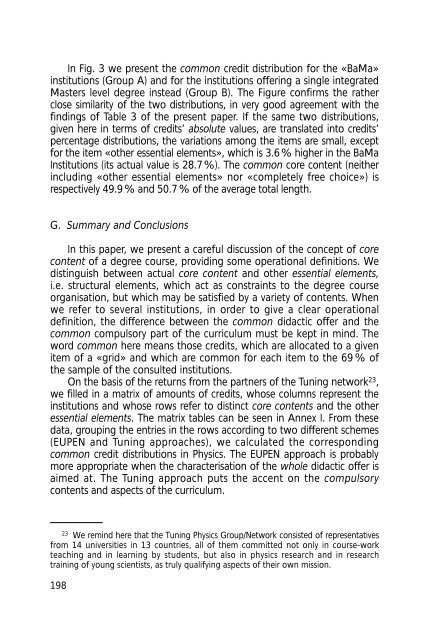Final Report Pilot Project - Relaciones Internacionales de la ...
Final Report Pilot Project - Relaciones Internacionales de la ...
Final Report Pilot Project - Relaciones Internacionales de la ...
You also want an ePaper? Increase the reach of your titles
YUMPU automatically turns print PDFs into web optimized ePapers that Google loves.
In Fig. 3 we present the common credit distribution for the «BaMa»<br />
institutions (Group A) and for the institutions offering a single integrated<br />
Masters level <strong>de</strong>gree instead (Group B). The Figure confirms the rather<br />
close simi<strong>la</strong>rity of the two distributions, in very good agreement with the<br />
findings of Table 3 of the present paper. If the same two distributions,<br />
given here in terms of credits’ absolute values, are trans<strong>la</strong>ted into credits’<br />
percentage distributions, the variations among the items are small, except<br />
for the item «other essential elements», which is 3.6 % higher in the BaMa<br />
Institutions (its actual value is 28.7 %). The common core content (neither<br />
including «other essential elements» nor «completely free choice») is<br />
respectively 49.9 % and 50.7 % of the average total length.<br />
G. Summary and Conclusions<br />
In this paper, we present a careful discussion of the concept of core<br />
content of a <strong>de</strong>gree course, providing some operational <strong>de</strong>finitions. We<br />
distinguish between actual core content and other essential elements,<br />
i.e. structural elements, which act as constraints to the <strong>de</strong>gree course<br />
organisation, but which may be satisfied by a variety of contents. When<br />
we refer to several institutions, in or<strong>de</strong>r to give a clear operational<br />
<strong>de</strong>finition, the difference between the common didactic offer and the<br />
common compulsory part of the curriculum must be kept in mind. The<br />
word common here means those credits, which are allocated to a given<br />
item of a «grid» and which are common for each item to the 69 % of<br />
the sample of the consulted institutions.<br />
On the basis of the returns from the partners of the Tuning network 23 ,<br />
we filled in a matrix of amounts of credits, whose columns represent the<br />
institutions and whose rows refer to distinct core contents and the other<br />
essential elements. The matrix tables can be seen in Annex I. From these<br />
data, grouping the entries in the rows according to two different schemes<br />
(EUPEN and Tuning approaches), we calcu<strong>la</strong>ted the corresponding<br />
common credit distributions in Physics. The EUPEN approach is probably<br />
more appropriate when the characterisation of the whole didactic offer is<br />
aimed at. The Tuning approach puts the accent on the compulsory<br />
contents and aspects of the curriculum.<br />
23 We remind here that the Tuning Physics Group/Network consisted of representatives<br />
from 14 universities in 13 countries, all of them committed not only in course-work<br />
teaching and in learning by stu<strong>de</strong>nts, but also in physics research and in research<br />
training of young scientists, as truly qualifying aspects of their own mission.<br />
198


